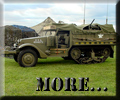


 |

|
 |
 |
| The typical power plant for an early White halftrack was a simple 386ci six-cylinder, L-head, White Hercules that produced 147hp. The maximum speed was around 40 - 50 mph, and the fording depth was 32 inches. It was able to travel 175 miles with its 60 gallons of fuel. |
 |
 |
 |
 |
 |
| The half-track mechanism was developed from the highly successful Marmon-Herrington design, and used a larger diameter driving wheel, and a similar non-driven rear idler. It used four roadwheels mounted on pivoting arms that were sprung with vertical volute springs mounted in a center box housing, and rode on a continuous rubber track with steel cables embedded. |
 |
 |
 |
| The M3A2 was the final model in the M3 series and was standardized in 1944. It was built by Autocar, Diamond T, and White, and was also the heaviest of the series at over 21,000 pounds gross. |
 |
 |
Its crew varied between 5 to 12 men, based on the special equipment needs of its use. |
| Special equipment could consist of a SCR-508 radio, or extra ammunition when carrying machine gun squads. |
 |
 |
The M3 half-track series evolved into what was to become one of the more famous vehicles of World War II, and remained essentially unchanged from 1941 through 1945. |